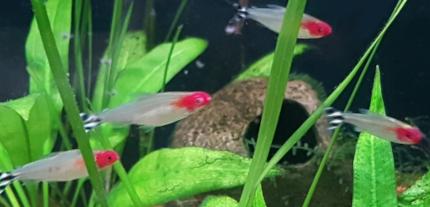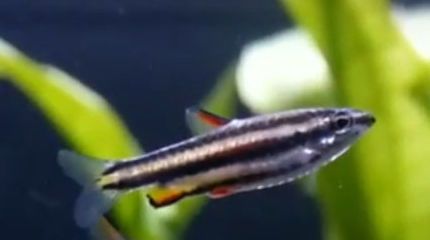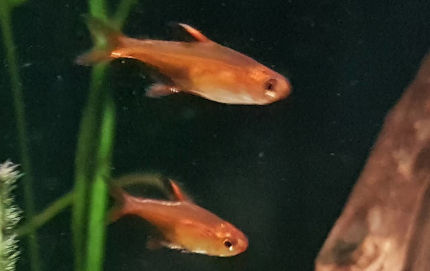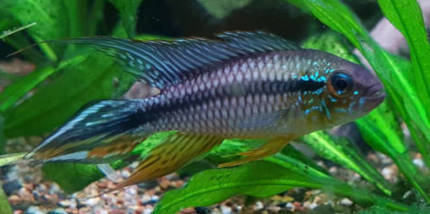The Rummy Nose Tetra is popular amongst aquarists and for good reason, they have fantastic distinctive colours, are good schooling fish and make a great addition to community tanks.
About Rummy Nose Tetras
Rummy Nose Tetra Profile
Origin: South America, amazon basin.
Size: 2 inches (5cm).
Minimum tank size: 15 gallons (35 litres) or more, keep in small schools. Best in a larger tank with some suitable tank mates.
Tank region: Middle. Spend majority of their time swimming in the middle region.
Water temperature:76 - 80 °F (24 - 27 °C)
Water conditions: Neutral slightly acidic water with PH between 5.5 to 7 is desirable. Soft water with a low TDS is preferred.
Difficulty to keep: Intermediate level
There are actually three species of fish often termed Rummy Nose Tetra:
- Hemigrammus rhodostomus (The True Rummy Nose Tetra)
- Hemigrammus bleheri (Known as the Common Rummy Nose Tetra)
- Petitella georgiae (The false Rummy Nose Tetra)
All three species originate from the South American amazon basin though originate from different specific locations. The behaviour and care instruction for all three species is more or less identical.
Rummy Nose tetras are well known for their distinctive markings, a bright red extending from the nose back to the gill plates and slightly beyond, a shimmering silver body and a forked tail with alternating black and white stripes. These small fish are absolutely beautiful!
Rummy Nose Tetra Behaviour and Personality
Rummy Nose Tetras are schooling fish and will demonstrate schooling behaviour in the aquarium when in groups of six or more. The larger the school the more stunning the schooling behaviour and with their fantastic colours make a stunning display within the aquarium.
They are peaceful fish and generally pose no issue or aggression towards other fish.
Rummy Nose Tetra Male vs Female
Although male and female Rummy Nose tetras are similar in length they differ in body shape.
Females are thicker and rounder especially when full of eggs prior to spawning. Males on the other hand are slimmer.

Aquarium Setup
Rummy Nose Tetras enjoy a planted aquarium and this can also help to show off their distinctive markings - their bright red nose and black and whit striped tail stand out against a bright green background of plants.
Usual aquarium equipment consisting of a heater, filter and lighting are required to maintain correct water conditions. Bright lights are not necessary and floating plants can be used to further dim the aquarium to help make the fish feel more safe.
Suitable Tank Mates for Rummy Nose Tetras
As Rummy Nose tetras are peaceful fish similarly peaceful fish make the most suitable tank mates, large and aggressive cichlids should be avoided.
Other Tetras, Dwarf Cichlids, Discus, Plecos, Otocinclus, Dwarf Pencilfish and Corydoras catfish are all suitable tank mates.
What to feed Rummy Nose Tetras?
As with most fish live food are best and Rummy Nose Tetras will enjoy feeding on freshly hatched brine shrimp. Feeding live foods is also a very good way to help condition them for breeding.
To supplement there diet dried flake or pellet foods can also be fed. I find my Rummy Nose tetras to like most small tropical fish pellets, slow sinking ones such as Hikari Micro pellets work well.
Breeding Rummy Nose Tetras
Rummy Nose tetras like many tetras are egg scatterers - the female will release eggs on to plants, among moss or spawning mops, the male follow closely and fertilises the eggs.
So a densely planted breeding tank or one with many spawning mops is best. Spawning mops or clumps of java moss are in many cases more practical.
Post spawning it is best to remove the adults as they are known to eat their own eggs.
Keep the breading tank with eggs in it dark as the eggs are sensitive to light. After 1 to 2 or so days the eggs should hatch and they will be free swimming at around 6 days.
The fry will initially feed of the egg sack but will then feed on micro organism and foods such as infusoria. They can then transition to eating baby brine shrimp.
Conclusion
Rummy Nose Tetras can be a great addition to a planted community tank. They have unique colours and are peaceful fish, so they not only look good but they also get along with other fish suited for community tanks.
Their colours will be most vibrant when they are in good health - with water parameters kept within the preferred ranges and being fed high quality foods.



